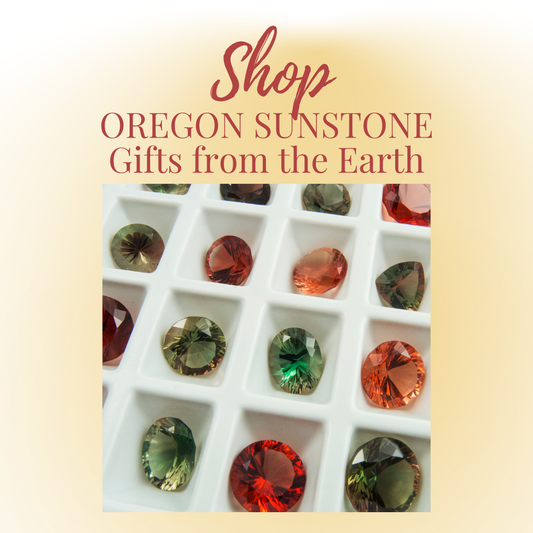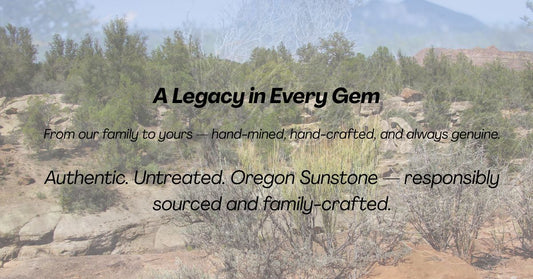When you think of autumn, the first thing that likely comes to mind is the stunning transformation of leaves, shifting from vivid greens to rich golds, fiery reds, and warm ambers. It’s a season that speaks to the heart with its array of earthy, comforting hues. The captivating colors of autumn bear a striking resemblance to the natural beauty of Oregon sunstones, one of the rarest and most distinctive gemstones in the world. These sunstones, found only in the high deserts of Oregon, showcase an extraordinary range of colors that reflect the richness of fall.
Want to know more about where and how Oregon Sunstone is mined? Click the links below
The Origins of Oregon Sunstone's Color
What gives Oregon sunstones their striking color variations? The answer lies in the unique chemical composition and crystal structure of these gems. Oregon sunstones are a variety of labradorite feldspar, but what sets them apart is the presence of trace amounts of copper within the stone.
These factors interplay in unique ways to create a spectrum of hues ranging from light yellow to deep red, green, and blue. Let’s break down the science behind how these colors form:
1. Copper Inclusions: The Key to Color
Sunstones formed tens of millions of years ago when copper-laden crystals flowed to the surface with volcanic magma. As the sunstone crystal forms, these tiny copper inclusions become suspended inside. Copper acts as a chromophore, or color-inducing agent, inside the gemstone, creating a range of colors. Depending on the concentration and size, these copper inclusions dictate the stone's hue:
-
Low Copper Content: Light Colors
Sunstones with lower concentrations of copper tend to have lighter colors, such as pale yellow or champagne. These stones have fewer copper platelets, resulting in a more translucent and subtle appearance. -
Medium Copper Content: Orange and Peach Tones
As the copper content increases, the sunstones take on warmer shades of orange and peach. The increased amount of copper begins to dominate the gemstone's internal structure, creating rich and saturated colors. -
High Copper Content: Red and Deep Orange
In sunstones with a high concentration of copper, the gemstone appears a vivid orange Oregon Sunstone. These colors are the most prized and rarest, and they occur when the copper platelets are densely packed within the crystal.

2. Schiller Effect: The Autumnal Sparkle
Many Oregon sunstones also exhibit a "schiller" effect, a shimmering optical phenomenon caused by the reflection of light off the copper inclusions. The schiller appears as a metallic luster or glow, particularly in sunstones with larger or more densely packed copper particles. This gives the stone a unique glitter that can shift in intensity depending on the viewing angle.
Much like the way sunlight filters through autumn leaves, casting a warm, golden glow, the schiller effect in Oregon sunstones captures the light in a soft, ethereal way. The stone almost seems to “dance” with the light, enhancing its autumn-like beauty.
3. Other Color Influences: Crystal Structure and Trace Elements
While copper is the primary agent of color in Oregon sunstones, the gemstone’s crystal structure also plays a role in how light is refracted within the stone, influencing how we perceive the color. The feldspar matrix scatters light in different ways, allowing for a diverse range of shades even within the same color family.
Additionally, trace elements such as iron, manganese, and titanium can further tweak the sunstone’s colors, sometimes resulting in rare green or blue stones. These colors are much less common and are caused by the interaction of these trace minerals with the copper inclusions. Green Oregon sunstones, for example, have a blend of copper and iron, while blue hues may result from a specific alignment of copper platelets and the presence of other minerals.
4. Color Zoning: Nature’s Autumn Palette
Another fascinating feature of Oregon sunstones is their natural color zoning, where a single stone may display multiple hues, blending gradually or in stark contrast. Some sunstones can show shades of orange, red, and green within the same crystal, mimicking the multi-toned appearance of an autumn forest. This natural variation makes each sunstone unique, much like no two autumn landscapes are identical.







